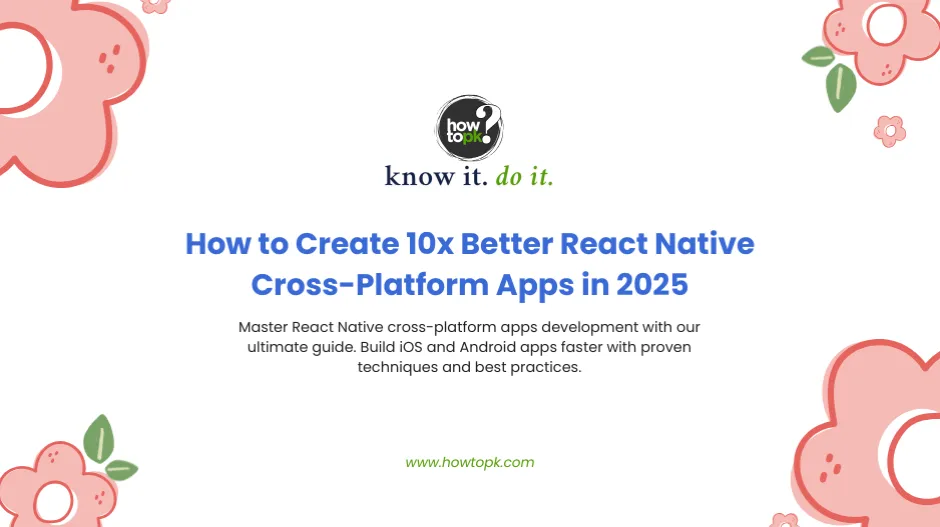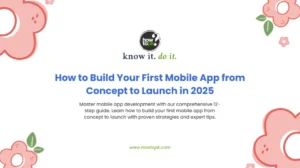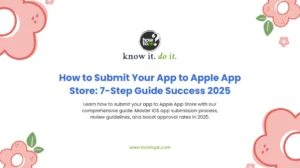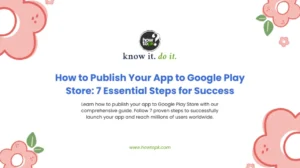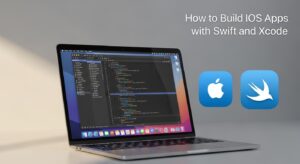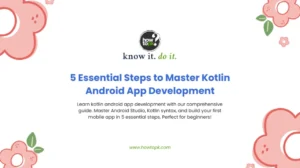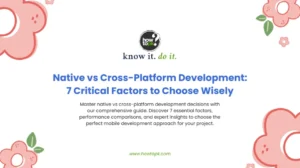Building React Native cross-platform apps has revolutionized mobile development, allowing developers to create stunning iOS and Android applications with a single codebase. This comprehensive guide will walk you through everything you need to know to master React Native development and create exceptional cross-platform mobile experiences.
What Are React Native Cross-Platform Apps?
React Native cross-platform apps are mobile applications built using Facebook’s React Native framework that can run seamlessly on both iOS and Android devices. Unlike traditional native development that requires separate codebases for each platform, React Native enables developers to write once and deploy everywhere.
The framework leverages JavaScript and React principles while providing native performance through bridge communication with platform-specific APIs. This approach significantly reduces development time, costs, and maintenance overhead while delivering near-native user experiences.
Why Choose React Native for Cross-Platform Development?
- Cost-Effective Development: React Native cross-platform apps reduce development costs by up to 60% compared to building separate native applications. Companies like Facebook, Instagram, and Walmart have saved millions by adopting this approach.
- Faster Time-to-Market: With a single codebase serving both platforms, React Native development cycles are typically 30-50% faster than traditional native development. This speed advantage is crucial in today’s competitive mobile landscape.
- Strong Community Support: The React Native ecosystem boasts over 2,000 third-party libraries and a vibrant community of developers. This extensive support network ensures solutions for virtually any development challenge.
Essential Prerequisites for React Native Development
Before diving into React Native cross-platform apps development, ensure you have these fundamentals covered:
Requirement | Description | Proficiency Level |
JavaScript (ES6+) | Modern JavaScript syntax and concepts | Intermediate |
React | Component-based architecture understanding | Intermediate |
Mobile UI/UX | Basic mobile design principles | Beginner |
Git | Version control fundamentals | Beginner |
CLI Tools | Command line interface comfort | Beginner |
Setting Up Your React Native Development Environment
1. Install Node.js and npm
Download the latest LTS version from Node.js official website. Verify installation:
node --version
npm --version
2. Install React Native CLI
npm install -g react-native-cli
# Or use npx for the latest version
npx react-native --version
3. Set Up Platform-Specific Tools
For iOS Development:
- Install Xcode from the Mac App Store
- Install Xcode Command Line Tools
- Configure iOS Simulator
For Android Development:
- Install Android Studio
- Configure Android SDK
- Set up Android Virtual Device (AVD)
4. Create Your First Project
npx react-native init MyFirstApp
cd MyFirstApp
Building Your First React Native Cross-Platform App
Let’s create a simple todo application that demonstrates core React Native concepts:
Project Structure Overview
MyFirstApp/
├── android/ # Android-specific files
├── ios/ # iOS-specific files
├── src/ # Source code
├── App.js # Main application component
├── package.json # Dependencies
└── metro.config.js # Metro bundler configuration
Core Components Implementation
React Native cross-platform apps rely on built-in components that automatically adapt to each platform’s design guidelines:
- View: Container component (similar to HTML div)
- Text: Text display component
- ScrollView: Scrollable content container
- TextInput: User input field
- TouchableOpacity: Touchable wrapper
Advanced React Native Cross-Platform Development Techniques
State Management with Redux
For complex React Native cross-platform apps, implement Redux for predictable state management:
npm install redux react-redux @reduxjs/toolkit
Navigation Implementation
Use React Navigation for seamless navigation experiences:
npm install @react-navigation/native @react-navigation/stack
Performance Optimization Strategies
1. Image Optimization
- Use appropriate image formats (WebP for Android, optimized PNG/JPEG for iOS)
- Implement lazy loading for image-heavy screens
- Cache images locally using libraries like react-native-fast-image
2. Memory Management
- Remove event listeners in component cleanup
- Optimize FlatList rendering with getItemLayout
- Use React.memo for expensive component renders
3. Bundle Optimization
- Enable Hermes JavaScript engine for Android
- Implement code splitting for large applications
- Use ProGuard/R8 for Android release builds
Platform-Specific Customizations
While React Native cross-platform apps share most code, platform-specific customizations are sometimes necessary:
Conditional Platform Rendering
import { Platform } from 'react-native';
const styles = StyleSheet.create({
container: {
paddingTop: Platform.OS === 'ios' ? 20 : 0,
},
});
Platform-Specific Files
Create separate files with .ios.js and .android.js extensions:
Button.ios.js– iOS-specific implementationButton.android.js– Android-specific implementation
Essential Libraries for React Native Development
Library | Purpose | GitHub Stars |
React Navigation | Navigation solution | 22k+ |
React Native Vector Icons | Icon library | 16k+ |
Async Storage | Data persistence | 4k+ |
React Native Maps | Map integration | 14k+ |
React Native Camera | Camera functionality | 9k+ |
Testing Your React Native Cross-Platform Apps
Unit Testing with Jest
React Native projects come with Jest configured by default:
npm test
Integration Testing
Use Detox for end-to-end testing across platforms:
npm install -g detox-cli
npm install --save-dev detox
Manual Testing Best Practices
- Test on multiple device sizes and orientations
- Verify performance on older devices
- Test offline functionality
- Validate accessibility features
Deployment and Distribution
iOS App Store Deployment
- Configure app signing in Xcode
- Create App Store Connect listing
- Upload build using Xcode Organizer
- Submit for review
Google Play Store Deployment
- Generate signed APK/AAB
- Create Play Console listing
- Upload build to Play Console
- Configure release tracks
Continuous Integration/Deployment
Implement CI/CD pipelines using:
- GitHub Actions
- Bitrise
- CodePush for over-the-air updates
Common Challenges and Solutions
Bridge Performance Issues
- Minimize bridge communications
- Use native modules for intensive operations
- Implement proper data serialization
Platform Inconsistencies
- Test extensively on both platforms
- Use platform-specific design patterns
- Leverage community solutions for common issues
Third-Party Library Compatibility
- Check library maintenance status
- Verify platform support
- Have fallback solutions ready
Future of React Native Cross-Platform Development
React Native continues evolving with exciting developments:
New Architecture (Fabric + TurboModules)
The new architecture promises:
- Improved performance
- Better type safety
- Enhanced developer experience
Hermes JavaScript Engine
Google’s Hermes engine provides:
- Faster app startup times
- Reduced memory usage
- Smaller app bundle sizes
Best Practices for React Native Cross-Platform Apps
Code Organization
- Implement consistent folder structure
- Use absolute imports with module resolution
- Separate business logic from UI components
Performance Monitoring
- Integrate Flipper for debugging
- Use React Native Performance tools
- Monitor crash analytics with services like Crashlytics
Security Considerations
- Implement secure storage for sensitive data
- Use HTTPS for network communications
- Validate all user inputs
- Implement proper authentication flows
Conclusion
React Native cross-platform apps represent the future of efficient mobile development. By mastering the techniques outlined in this guide, you’ll be equipped to build high-quality applications that deliver exceptional user experiences across both iOS and Android platforms.
The framework’s continuous evolution, strong community support, and proven track record make it an excellent choice for businesses and developers looking to maximize their mobile development investment. Start building your React Native cross-platform apps today and join the millions of developers who have already embraced this powerful technology.
Remember that successful React Native development requires continuous learning and adaptation to new best practices. Stay connected with the community, contribute to open-source projects, and never stop experimenting with new techniques to improve your React Native cross-platform apps.

